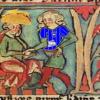| Suffolk arcaheology news on 08:57 - Nov 23 with 2606 views | DJR |
I'm just listening to an article on it on the Today programme on Radio 4. [Post edited 23 Nov 2023 8:58]
|  | |  |
| Suffolk arcaheology news on 09:46 - Nov 23 with 2532 views | Keno |
it that what the aliens were visiting? |  |
|  |
| Suffolk arcaheology news on 09:58 - Nov 23 with 2507 views | leitrimblue |
That really is quite an impressive thing. ( I'm not very easily or very often impressed by archaeological stuff, especially Saxon) I'm guessing the scale of it would make it unique to the UK and Ireland for that period. Would also sort of go part of the way to explaining the scale and artifact wealth of the Sutton Hoo Burials. Rather then being randomly located they were part of this large and extraordinary enclosed complex |  | |  |
| Suffolk arcaheology news on 10:14 - Nov 23 with 2480 views | eireblue |
| Suffolk arcaheology news on 09:46 - Nov 23 by Keno |
it that what the aliens were visiting? |
Even aliens accidentally leave their keys behind. |  | |  |
| Suffolk arcaheology news on 10:52 - Nov 23 with 2406 views | ford6600 |
Yes interesting news. There had to be a major settlement associated with the nearby Sutton Hoo burials.
Archaeologists love finding temples, hope they're
right, or may be a grain store... |  | |  |
| Suffolk arcaheology news on 11:04 - Nov 23 with 2379 views | Guthrum |
| Suffolk arcaheology news on 09:58 - Nov 23 by leitrimblue |
That really is quite an impressive thing. ( I'm not very easily or very often impressed by archaeological stuff, especially Saxon) I'm guessing the scale of it would make it unique to the UK and Ireland for that period. Would also sort of go part of the way to explaining the scale and artifact wealth of the Sutton Hoo Burials. Rather then being randomly located they were part of this large and extraordinary enclosed complex |
Ruled by (assuming it is indeed Raedwald of the historical records), probably the most powerful king in England at the time - or at least its eastern and northern parts.
Bede does refer to him having a base at Rendlesham. |  |
|  |
| Suffolk arcaheology news on 11:17 - Nov 23 with 2332 views | leitrimblue |
| Suffolk arcaheology news on 11:04 - Nov 23 by Guthrum |
Ruled by (assuming it is indeed Raedwald of the historical records), probably the most powerful king in England at the time - or at least its eastern and northern parts.
Bede does refer to him having a base at Rendlesham. |
I always find any crossover between early written history and the archaeological record very interesting. Saxon archaeology is not my strong point due to working in Ireland for the last 20 odd years but I would have thought discovering a site and structures on this scale and grandeur would increase the likelihood of the site and therefore probably the burials being connected to Raedwald |  | |  |
| Suffolk arcaheology news on 11:28 - Nov 23 with 2313 views | leitrimblue |
| Suffolk arcaheology news on 10:52 - Nov 23 by ford6600 |
Yes interesting news. There had to be a major settlement associated with the nearby Sutton Hoo burials.
Archaeologists love finding temples, hope they're
right, or may be a grain store... |
So true, archaeologists absolutely love to big up their finds and always think the most mundane of features are really temples, villas, or some kinda prehistoric enclosure. 20 odd years ago I worked for the Cambridge Archaeological Unit, there was a well known retired Cambridge professor who use to come out an look at any Ronan sites we had. He would claim instantly then more then 4 stones in a row was a wall and that 2 walls were potentially a roman villa. We would then spend a few weeks frantically trying to discover this villa before declaring it was just a few stones in a row |  | |  |
Login to get fewer ads
| Suffolk arcaheology news on 11:38 - Nov 23 with 2282 views | Guthrum |
| Suffolk arcaheology news on 11:17 - Nov 23 by leitrimblue |
I always find any crossover between early written history and the archaeological record very interesting. Saxon archaeology is not my strong point due to working in Ireland for the last 20 odd years but I would have thought discovering a site and structures on this scale and grandeur would increase the likelihood of the site and therefore probably the burials being connected to Raedwald |
It would (and the assumption has been made ever since Sutton Hoo Mound 1 was excavated).
However, as so often with this period, written records are very sparse and frequently later, second-hand renderings of the information*. Annals or records kept by East Anglian monasteries may not have survived the Danish raids/invasions of the 9th century (or the Cotton Library fire). So it might have been Raedwald or it may have been another East Anglian king of the era - altho obviously a particularly powerful and wealthy one.
* Bede was at least writing within about a century, citing someone he may have met who was a grand-nephew of Raedwald and had, when a boy, seen the temple with both Christian and pagan altars. |  |
|  |
| Suffolk arcaheology news on 11:49 - Nov 23 with 2252 views | Keno |
| Suffolk arcaheology news on 11:28 - Nov 23 by leitrimblue |
So true, archaeologists absolutely love to big up their finds and always think the most mundane of features are really temples, villas, or some kinda prehistoric enclosure. 20 odd years ago I worked for the Cambridge Archaeological Unit, there was a well known retired Cambridge professor who use to come out an look at any Ronan sites we had. He would claim instantly then more then 4 stones in a row was a wall and that 2 walls were potentially a roman villa. We would then spend a few weeks frantically trying to discover this villa before declaring it was just a few stones in a row |
Obviously I'm waiting to hear the valued and highly respected opinion of Francis Pryor
 |  |
|  |
| Suffolk arcaheology news on 11:52 - Nov 23 with 2239 views | leitrimblue |
| Suffolk arcaheology news on 11:38 - Nov 23 by Guthrum |
It would (and the assumption has been made ever since Sutton Hoo Mound 1 was excavated).
However, as so often with this period, written records are very sparse and frequently later, second-hand renderings of the information*. Annals or records kept by East Anglian monasteries may not have survived the Danish raids/invasions of the 9th century (or the Cotton Library fire). So it might have been Raedwald or it may have been another East Anglian king of the era - altho obviously a particularly powerful and wealthy one.
* Bede was at least writing within about a century, citing someone he may have met who was a grand-nephew of Raedwald and had, when a boy, seen the temple with both Christian and pagan altars. |
I don't know Bede as well as the early Irish writers but when it comes down to dates of Kings and describing historical acts they seem quite accurate.
Though yer completely correct about it being just as possible that it belongs to a separate lesser known wealthy Saxon King |  | |  |
| Suffolk arcaheology news on 11:54 - Nov 23 with 2225 views | leitrimblue |
| Suffolk arcaheology news on 11:49 - Nov 23 by Keno |
Obviously I'm waiting to hear the valued and highly respected opinion of Francis Pryor
 |
He says its aliens  |  | |  |
| Suffolk arcaheology news on 12:06 - Nov 23 with 2194 views | Guthrum |
| Suffolk arcaheology news on 11:52 - Nov 23 by leitrimblue |
I don't know Bede as well as the early Irish writers but when it comes down to dates of Kings and describing historical acts they seem quite accurate.
Though yer completely correct about it being just as possible that it belongs to a separate lesser known wealthy Saxon King |
The contemporary ones, yes. Those filled in later for earlier periods, e.g. the Anglo-Saxon Chronicle pre-9th century entries contain a lot of guesswork, legends, myths and outright invention.
Likewise genealogies often veer off into "who we'd like to have been descended from" (often for dynastic legitimising purposes), rather than who they actually were.
p.s. Anglish, not Saxon! |  |
|  |
| Suffolk arcaheology news on 12:12 - Nov 23 with 2166 views | ITFC_Forever |
I look forward to the 2023 version of The Dig being recorded. |  |
|  |
| Suffolk arcaheology news on 13:43 - Nov 23 with 1974 views | leitrimblue |
| Suffolk arcaheology news on 12:06 - Nov 23 by Guthrum |
The contemporary ones, yes. Those filled in later for earlier periods, e.g. the Anglo-Saxon Chronicle pre-9th century entries contain a lot of guesswork, legends, myths and outright invention.
Likewise genealogies often veer off into "who we'd like to have been descended from" (often for dynastic legitimising purposes), rather than who they actually were.
p.s. Anglish, not Saxon! |
I mainly work as an archaeological consultant in commercial archaeology, but a couple of years ago I did a small bit of community archaeology alongside this. I was asked to look at this large cross engraved stone found in a field not far from me in Co sligo. I arranged for a geophysical survey of the area around it and discovered what is thought to be a medieval sgoilteach. These quite rare buildings were constructed and maintained on the land holdings of Gaelic learned families ( in this case probably the O Dhaleigh) who were often attached to Gaelic lords. It's possibly were the writers of the book of Ballymote ( well worth having a look at) and other Connaught manuscripts spent much of their time. The Gaelic book writing tradition was very big in the North West of Ireland, and though I'm really a prehistorian I find much of their contents, how they were produced etc very interesting. It's easy to see the importance these books held and there are many a battle over the ownership of these books. The earlier 6/7C battle of the books (battle of Cul Dreimhne) (though possibly more of a copyright issue then a ownership one) around Drumcliffe in Co Sligo lead to Colmcille leaving Ireland and taking Christianity to the UK |  | |  |
| Suffolk arcaheology news on 14:05 - Nov 23 with 1908 views | factual_blue |
| Suffolk arcaheology news on 11:28 - Nov 23 by leitrimblue |
So true, archaeologists absolutely love to big up their finds and always think the most mundane of features are really temples, villas, or some kinda prehistoric enclosure. 20 odd years ago I worked for the Cambridge Archaeological Unit, there was a well known retired Cambridge professor who use to come out an look at any Ronan sites we had. He would claim instantly then more then 4 stones in a row was a wall and that 2 walls were potentially a roman villa. We would then spend a few weeks frantically trying to discover this villa before declaring it was just a few stones in a row |
My lecturer in Early English Mediaeval History (Eric John) was scathing about archaeologists, who he considered had managed to present the world from pre-Roman times to the Anglo-Saxon era as totally obsessed with death to the exclusion of virtually everything else, as all finds were considered to be tomb goods, temples and so on.
He was a strange man. Always looked like he lived in a skip. |  |
|  |
| Suffolk arcaheology news on 14:52 - Nov 23 with 1839 views | leitrimblue |
| Suffolk arcaheology news on 14:05 - Nov 23 by factual_blue |
My lecturer in Early English Mediaeval History (Eric John) was scathing about archaeologists, who he considered had managed to present the world from pre-Roman times to the Anglo-Saxon era as totally obsessed with death to the exclusion of virtually everything else, as all finds were considered to be tomb goods, temples and so on.
He was a strange man. Always looked like he lived in a skip. |
He wasn't miles away from the truth |  | |  |
| Suffolk arcaheology news on 15:17 - Nov 23 with 1779 views | DJR |
| Suffolk arcaheology news on 12:06 - Nov 23 by Guthrum |
The contemporary ones, yes. Those filled in later for earlier periods, e.g. the Anglo-Saxon Chronicle pre-9th century entries contain a lot of guesswork, legends, myths and outright invention.
Likewise genealogies often veer off into "who we'd like to have been descended from" (often for dynastic legitimising purposes), rather than who they actually were.
p.s. Anglish, not Saxon! |
I may be wrong but I am not sure there was that much contemporary writing during the Dark Ages, or at least little that has survived. Often things were written down some time later, the history or story perhaps having been handed down orally, but not always accurately, and sometimes as you suggest embellished.
Religious hagiographies spring to mind, especially for Dark Age saints. [Post edited 23 Nov 2023 15:24]
|  | |  |
| Suffolk arcaheology news on 16:07 - Nov 23 with 1728 views | leitrimblue |
| Suffolk arcaheology news on 15:17 - Nov 23 by DJR |
I may be wrong but I am not sure there was that much contemporary writing during the Dark Ages, or at least little that has survived. Often things were written down some time later, the history or story perhaps having been handed down orally, but not always accurately, and sometimes as you suggest embellished.
Religious hagiographies spring to mind, especially for Dark Age saints. [Post edited 23 Nov 2023 15:24]
|
Think there may have been a fair bit of writing from that period, much of it religious, just very little of it survives.
You have to think that the highly illustrated book of Kells is thought to be from around 800AD. There appears to be a large amount of literature produced out of Irish monasteries from the 6th to 9th centuries using the same insular style decoration but with less complex illustration. Hinting that the the Book of Kells is from the end of this tradition |  | |  |
| Suffolk arcaheology news on 16:17 - Nov 23 with 1698 views | DJR |
| Suffolk arcaheology news on 16:07 - Nov 23 by leitrimblue |
Think there may have been a fair bit of writing from that period, much of it religious, just very little of it survives.
You have to think that the highly illustrated book of Kells is thought to be from around 800AD. There appears to be a large amount of literature produced out of Irish monasteries from the 6th to 9th centuries using the same insular style decoration but with less complex illustration. Hinting that the the Book of Kells is from the end of this tradition |
Yes, there will have been religious writing in Latin, but with occasional writings in the margin in, say, Old Irish. But as you say not much of that will have survived.
I think I was more getting at what might be called histories, poetry or origin myths.
As regards the Book of Kells there are indications that it was written at Iona but taken to Ireland for safe keeping when the Vikings attacked. [Post edited 23 Nov 2023 16:19]
|  | |  |
| Suffolk arcaheology news on 16:27 - Nov 23 with 1674 views | leitrimblue |
| Suffolk arcaheology news on 16:17 - Nov 23 by DJR |
Yes, there will have been religious writing in Latin, but with occasional writings in the margin in, say, Old Irish. But as you say not much of that will have survived.
I think I was more getting at what might be called histories, poetry or origin myths.
As regards the Book of Kells there are indications that it was written at Iona but taken to Ireland for safe keeping when the Vikings attacked. [Post edited 23 Nov 2023 16:19]
|
There is indeed. Iona I think was established by Colmcille (Columba) after the battle of the books ( see my reply about the battle of the books to Guthrum above) . So the book of Kells sorta did a full circle.
Yer, I think yer probably right about the majority of the histories, poems and origin myths being wrote down slightly after this period. ( sorry, this period is slightly outside my comfort zone) |  | |  |
| Suffolk arcaheology news on 16:30 - Nov 23 with 1662 views | factual_blue |
| Suffolk arcaheology news on 14:52 - Nov 23 by leitrimblue |
He wasn't miles away from the truth |
In addition I seem to recall he never forgave Stenton for refusing to give him a PhD. |  |
|  |
| Suffolk arcaheology news on 16:34 - Nov 23 with 1650 views | DJR |
| Suffolk arcaheology news on 16:27 - Nov 23 by leitrimblue |
There is indeed. Iona I think was established by Colmcille (Columba) after the battle of the books ( see my reply about the battle of the books to Guthrum above) . So the book of Kells sorta did a full circle.
Yer, I think yer probably right about the majority of the histories, poems and origin myths being wrote down slightly after this period. ( sorry, this period is slightly outside my comfort zone) |
No worries at all. Your input in areas like this is always informative. |  | |  |
| Suffolk arcaheology news on 19:13 - Nov 23 with 1540 views | Guthrum |
| Suffolk arcaheology news on 15:17 - Nov 23 by DJR |
I may be wrong but I am not sure there was that much contemporary writing during the Dark Ages, or at least little that has survived. Often things were written down some time later, the history or story perhaps having been handed down orally, but not always accurately, and sometimes as you suggest embellished.
Religious hagiographies spring to mind, especially for Dark Age saints. [Post edited 23 Nov 2023 15:24]
|
It's more the case that little has survived than that there wasn't much written material to start off with. People, particularly monks, priests and administrators, were writing stuff down all the time. Charters, chronicles, genealogies, religious texts, letters to one another.
The problem is that parchment is a decompsable organic material, which can also be scraped clean of ink and re-used (which did happen). People only saved stuff if it was worthwhile at the time. Plus there were periods when things got destroyed by war and other events (not just the Vikings and the Dissolution of the Monasteries - during the French Revolution someone only just managed to save the Bayeux Tapestry, which was being used to cover the goods in a cart). Plus fires, floods and simply things getting lost.
Another issue is that many ancient and early medieval documents which have survived are, in fact, later copies - in whole, part or even just a few quotes. With anonymous or non-datable writings, that can cause a lot of uncertainty about when it was originally composed. Later writers may have had access to now lost sources (which may or may not have been accurately used). |  |
|  |
| Suffolk arcaheology news on 19:22 - Nov 23 with 1517 views | Guthrum |
| Suffolk arcaheology news on 13:43 - Nov 23 by leitrimblue |
I mainly work as an archaeological consultant in commercial archaeology, but a couple of years ago I did a small bit of community archaeology alongside this. I was asked to look at this large cross engraved stone found in a field not far from me in Co sligo. I arranged for a geophysical survey of the area around it and discovered what is thought to be a medieval sgoilteach. These quite rare buildings were constructed and maintained on the land holdings of Gaelic learned families ( in this case probably the O Dhaleigh) who were often attached to Gaelic lords. It's possibly were the writers of the book of Ballymote ( well worth having a look at) and other Connaught manuscripts spent much of their time. The Gaelic book writing tradition was very big in the North West of Ireland, and though I'm really a prehistorian I find much of their contents, how they were produced etc very interesting. It's easy to see the importance these books held and there are many a battle over the ownership of these books. The earlier 6/7C battle of the books (battle of Cul Dreimhne) (though possibly more of a copyright issue then a ownership one) around Drumcliffe in Co Sligo lead to Colmcille leaving Ireland and taking Christianity to the UK |
There seems to have been a lot more continuity in Ireland than Britain/England, probably through having avoided the post-Roman dislocation and the worst of the early Viking depredations. |  |
|  |
| |